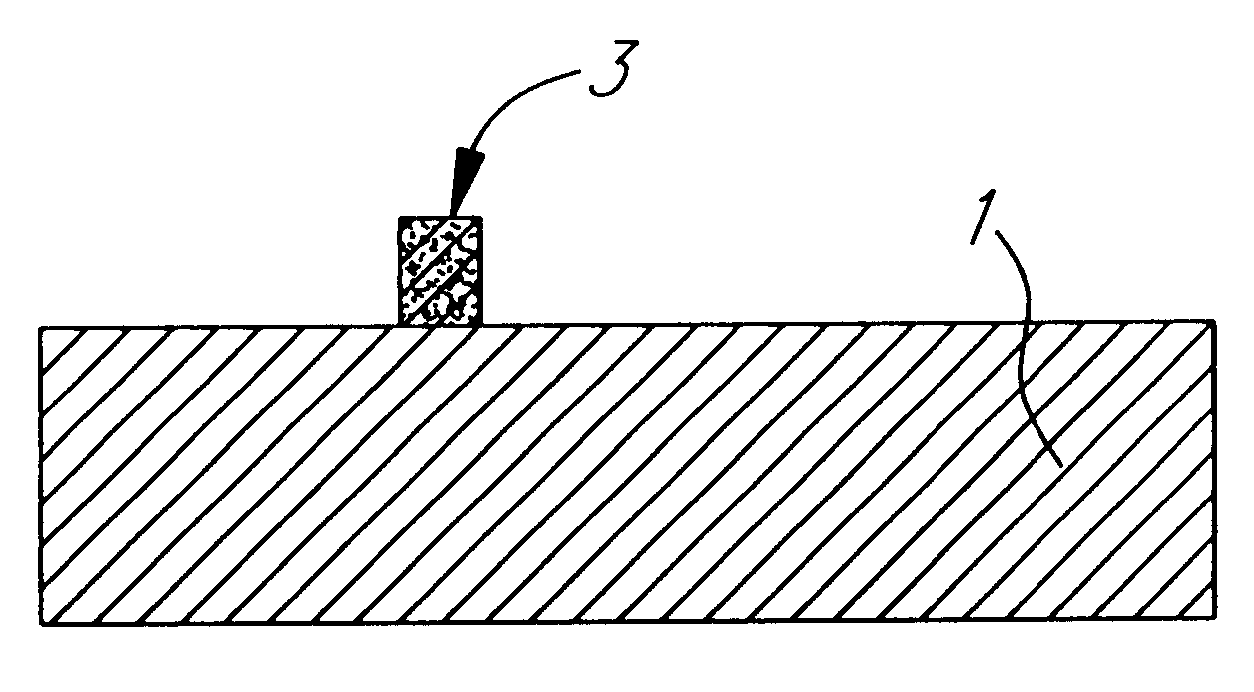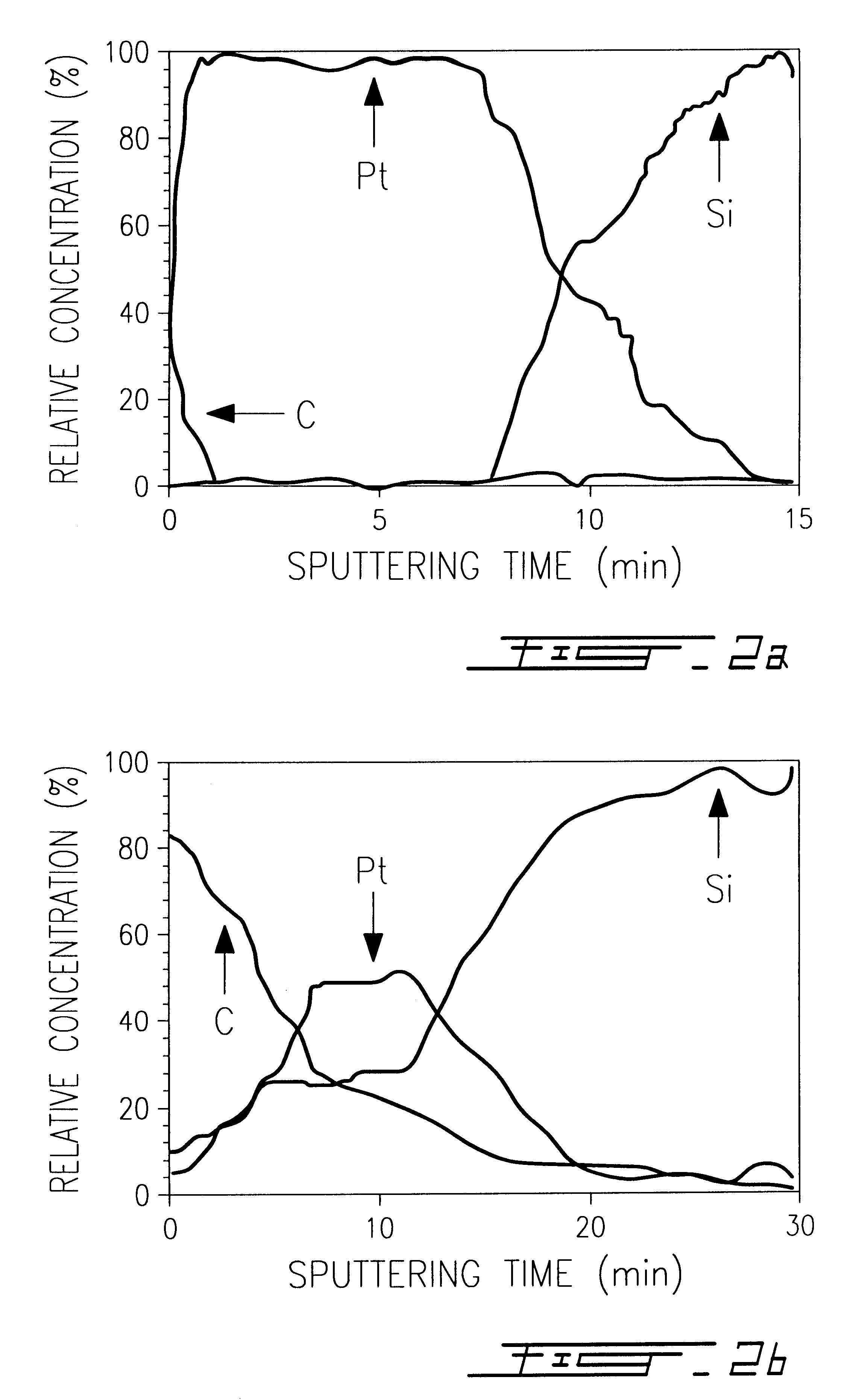Fabrication of sub-micron etch-resistant metal/semiconductor structures using resistless electron beam lithography
a technology of electron beam lithography and metal/semiconductor, which is applied in the direction of photomechanical equipment, instruments, originals for photomechanical treatment, etc., can solve the problems of inconvenient operation, inconvenient use, and inability to meet the requirements of the lithographic process
- Summary
- Abstract
- Description
- Claims
- Application Information
AI Technical Summary
Benefits of technology
Problems solved by technology
Method used
Image
Examples
example 2
As an example to form fine structures using 20 nm of Pt evaporated on a silicon substrate, a 3 keV electron beam would be adequate. In fact linewidths less than 50 nm have been obtained using a 100 pA electron beam (.apprxeq.200 mA / cm.sup.2), 1.5 .mu.C / cm dose. In this case, to reduce the carbon contamination and the local charging effects, the complete dose was achieved by multiple exposition (J. Fujita, H. Watanabe, Y. Ochiai, S. Manako, J. S. Tsai and S. Matsui, Appl. Phys. Lett., 66, 3065 (1995)). More specifically, each segment of the microstructure has been exposed 20 times using a reduced line dose of 0.075 .mu.C / cm. The effect of carbon contamination is to absorb some of the electron energy, thus reducing the amount of energy lost in the metal layer and decreasing the temperature rise. This technique of multiple exposition reduces the total line dose required for threshold, by reducing the rate of carbon deposition. Multiple repetition also significantly decreases the linewi...
example 3
The details of the method presented in this example will emphasize the particular case of fabrication of masks for X-ray lithography using a platinum silicide. The activation energy to form the first type of platinum silicide (Pt.sub.2 Si) is around 1.4 eV and the temperature range for a complete transformation of Pt into Pt.sub.6 Si is from 200-350.degree. C. [Colgan, E. G, Journal of Material Resistance, 10, 1953, (1995)]. A focused electron beam of a standard scanning electron microscope (SEM) at low energy (1 to 3 keV) provides sufficient energy to locally form this silicide, despite the heat dissipation in the material.
A tantalum layer of 450 nm was evaporated onto a clean X-ray transparent material (glass) using an electron gun deposition system. Using the same deposition system, a 40 nm layer of silicon and a 20 nm layer of platinum are deposited in sequence. The electron beam lithography system consists of a JEOL JSM-6300 scanning electron microscope (SEM) equipped with a tu...
example 4
Another example of the method is the fabrication of molds for nanoimprint lithography. These molds need to be resistant to mechanical constraints that are applied to transfer the pattern from the mold to a mechanically impressible surface. The fabrication of molds requires an etch mask which has both high resolution and excellent resistance to the chemicals used to etch the mold substrate. With our technique, a mechanically resistant substrate (such as tantalum or silicon carbide) is covered by a thin layer of silicon, followed by a thin layer of a metal able to form silicide. The electron beam lithography system transfers the pattern by forming silicide regions on the surface. Wet etching in a strong acid is used to remove the thin metal layer in unexposed regions. Similarly, a plasma etch or a wet etch can be used to remove the thin silicon layer in unexposed regions. A reactive ion etcher or any directional etching process can then be used to etch the substrate. Exposed regions o...
PUM
| Property | Measurement | Unit |
|---|---|---|
| temperature | aaaaa | aaaaa |
| temperature | aaaaa | aaaaa |
| temperature | aaaaa | aaaaa |
Abstract
Description
Claims
Application Information
 Login to View More
Login to View More - R&D
- Intellectual Property
- Life Sciences
- Materials
- Tech Scout
- Unparalleled Data Quality
- Higher Quality Content
- 60% Fewer Hallucinations
Browse by: Latest US Patents, China's latest patents, Technical Efficacy Thesaurus, Application Domain, Technology Topic, Popular Technical Reports.
© 2025 PatSnap. All rights reserved.Legal|Privacy policy|Modern Slavery Act Transparency Statement|Sitemap|About US| Contact US: help@patsnap.com



